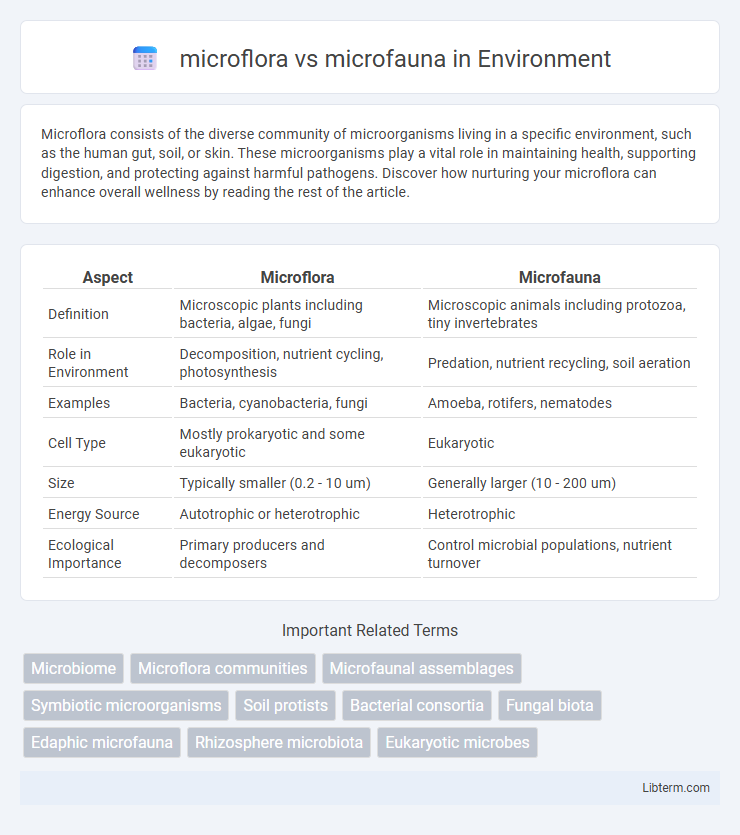Microflora consists of the diverse community of microorganisms living in a specific environment, such as the human gut, soil, or skin. These microorganisms play a vital role in maintaining health, supporting digestion, and protecting against harmful pathogens. Discover how nurturing your microflora can enhance overall wellness by reading the rest of the article.
Table of Comparison
| Aspect | Microflora | Microfauna |
|---|---|---|
| Definition | Microscopic plants including bacteria, algae, fungi | Microscopic animals including protozoa, tiny invertebrates |
| Role in Environment | Decomposition, nutrient cycling, photosynthesis | Predation, nutrient recycling, soil aeration |
| Examples | Bacteria, cyanobacteria, fungi | Amoeba, rotifers, nematodes |
| Cell Type | Mostly prokaryotic and some eukaryotic | Eukaryotic |
| Size | Typically smaller (0.2 - 10 um) | Generally larger (10 - 200 um) |
| Energy Source | Autotrophic or heterotrophic | Heterotrophic |
| Ecological Importance | Primary producers and decomposers | Control microbial populations, nutrient turnover |
Introduction to Microflora and Microfauna
Microflora refers to the community of microscopic plants, such as bacteria, algae, and fungi, inhabiting a specific environment, playing crucial roles in nutrient cycling and ecosystem functioning. Microfauna consists of tiny animals, including protozoa, nematodes, and rotifers, which contribute to soil health and organic matter decomposition through their feeding activities. Both microflora and microfauna maintain ecological balance by interacting within microbial food webs, influencing soil fertility and plant growth.
Defining Microflora: Key Characteristics
Microflora refers to the diverse community of microscopic plants, including bacteria, algae, and fungi, that inhabit various environments such as soil, water, and the human body. Key characteristics of microflora include its ability to perform photosynthesis, contribute to nutrient cycling, and maintain ecological balance by decomposing organic matter. These microorganisms play crucial roles in supporting health and sustaining ecosystems through symbiotic relationships and metabolic activities.
Understanding Microfauna: Features and Functions
Microfauna consists of microscopic animals such as protozoa, nematodes, and rotifers, which play a crucial role in soil and aquatic ecosystems by regulating microbial populations and facilitating nutrient cycling. These organisms contribute to the decomposition process by consuming bacteria and fungi, enhancing soil fertility and structure. Understanding microfauna functions helps improve ecosystem management and promotes sustainable agriculture practices.
Microflora vs Microfauna: Main Differences
Microflora primarily consists of microscopic plants such as bacteria, algae, and fungi that contribute to nutrient cycling and soil health. Microfauna includes tiny animals like protozoa, nematodes, and microarthropods, playing key roles in organic matter decomposition and soil structure maintenance. The main differences lie in their biological classification and ecological functions, with microflora being plant-based microorganisms and microfauna representing animal-based microorganisms.
Roles of Microflora in Ecosystems
Microflora, consisting of bacteria, fungi, and algae, plays a crucial role in nutrient cycling and organic matter decomposition within ecosystems. These microorganisms facilitate nitrogen fixation, enhance soil fertility, and contribute to plant growth by promoting nutrient uptake. Unlike microfauna, microflora primarily supports ecosystem productivity and stability through biochemical processes and symbiotic relationships.
Ecological Impact of Microfauna
Microfauna, comprising tiny animals like protozoa and microscopic invertebrates, play a crucial role in nutrient cycling and soil health by regulating microbial populations and decomposing organic matter. Their predatory activities influence microflora composition, enhancing soil fertility and promoting ecosystem stability. The ecological impact of microfauna extends to water purification and plant growth support, making them integral to maintaining balanced terrestrial and aquatic ecosystems.
Microflora and Microfauna in Human Health
Microflora, consisting of bacteria, fungi, and viruses, plays a crucial role in human health by maintaining gut integrity, aiding digestion, and regulating the immune system. Microfauna, including microscopic animals like protozoa and nematodes, contributes to nutrient cycling and supports the diversity and balance of microbial ecosystems in the human body. Both microflora and microfauna interact synergistically to enhance metabolic functions and protect against pathogenic infections.
Methods for Identifying Microflora and Microfauna
Methods for identifying microflora primarily involve culture techniques, microscopy, and molecular approaches such as 16S rRNA gene sequencing to detect bacterial and fungal species. Microfauna identification relies on microscopic examination, DNA barcoding, and metagenomic analysis to differentiate small animal organisms like nematodes, protozoa, and rotifers. Advanced high-throughput sequencing and environmental DNA (eDNA) sampling enhance the resolution and accuracy of microbial and microfaunal community profiling in various ecosystems.
Interactions Between Microflora and Microfauna
Microflora, consisting of bacteria, fungi, and algae, interacts dynamically with microfauna such as protozoa and nematodes, shaping ecosystem processes through nutrient cycling and organic matter decomposition. These interactions enhance microbial diversity and regulate population balances by predation and symbiotic relationships, influencing soil fertility and plant health. Understanding these interactions is essential for optimizing soil management and promoting sustainable agriculture.
Future Research Directions in Microbial and Faunal Studies
Future research directions in microbial and faunal studies emphasize integrating multi-omics technologies to unravel the complex interactions between microflora and microfauna within ecosystems. Advances in metagenomics and metabolomics will enhance understanding of their co-evolution, functional roles, and impact on environmental health and biogeochemical cycles. Exploring these relationships can lead to innovative biotechnological applications and improved ecosystem management strategies.
microflora Infographic

 libterm.com
libterm.com